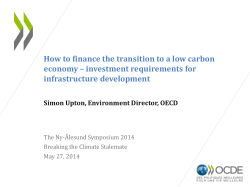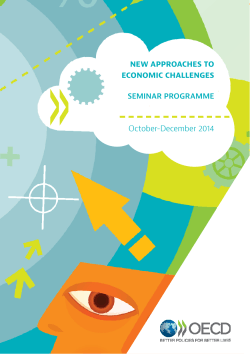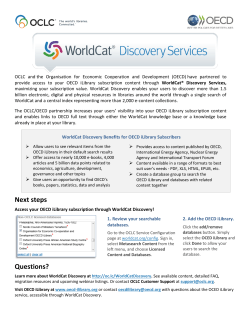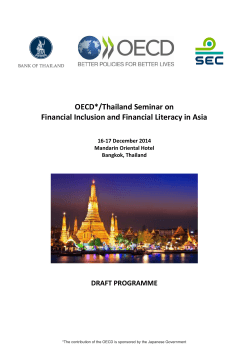
THE REVISION OF THE FRASCATI MANUAL
THE REVISION OF THE FRASCATI MANUAL Segundo Taller de Indicadores de Ciencia, Tecnología e Innovación Ciudad de México, 30-31 January 2014 Fernando GALINDO-RUEDA Head of S&T indicators unit Economic Analysis and Statistics Division Directorate for Science, Technology and Industry Frascati Manual (FM) www.oecd.org/sti/frascatimanual • The statistical guidelines used by OECD members and many partner economies to measure and report R&D efforts… …named after the Italian town where it was first discussed by NESTI in 1962. • But over time, also: – The de facto global standard for R&D measurement – The reference definition of R&D for several other activities – The first of a broader family of manuals • One of OECD’s and CSTP’s most visible outputs – E.g. in top 5 most translated OECD documents Requirements for a manual Relevant measurement / statistical experience Defined user needs Internationally adopted and comparable statistics R&D (human and financial) efforts across OECD and partner economies Researchers, per thousand employment R&D expenditures in 2005 USD - constant prices and PPP 16.0 1 billion ISL BRIICS North America EU Other OECD members FIN 10 billion 14.0 DNK 100 billion 12.0 KOR NOR SWE USA 10.0 PRT BEL CAN IRL 8.0 FRA AUS DEU NZL SVK JPN SVN AUT LUX GBR EST ESP NLD RUS 6.0 CZE HUN CHE GRC ITA 4.0 POL TUR 2.0 IDN MEX ZAF CHL IND CHN BRA 0.0 0.0 0.5 1.0 1.5 2.0 2.5 3.0 3.5 4.0 4.5 Gross domestic expenditures on R&D as a percentage of GDP Source: OECD Science, Technology and Industry Scoreboard 2013 http://dx.doi.org/10.1787/888932890124 R&D in OECD and key partner countries, 2011 Where to find the latest OECD R&D data? Please look for the real sources: • Main Science and Technology Indicators www.oecd.org/sti/msti.htm – Updated Jan and Jun each year. R&D, patents, R&D-intensive sectors output and trade • R&D Statistics database www.oecd.org/sti/rds – Detail R&D expenditure data and R&D budgets – Updated early March each year • R&D by industry – ANBERD www.oecd.org/sti/anberd.htm • R&D tax incentives – www.oecd.org/sti/rd-tax-stats.htm • Scoreboard – selection and experimental indicators www.oecd.org/sti/scoreboard New elements calling for a substantial revision Recurrent difficulties Relevant measurement experience New challenges New nonstatistical uses New statistical uses New policy interests and questions Use by countries with less developed infrastructures User needs Internationally adopted and comparable International statistical regulations Non-statistical uses of Frascati Manual EU Community framework for state aid for research and development and innovation (2006/C 323/01) When classifying different activities, the Commission will refer to its own practice as well as the specific examples and explanations provided in the Frascati Manual on the Measurement of Scientific and technological Activities, Proposed Standard Practice for Surveys on Research and Experimental Development. Frascati used to “rewrite economic history” Already done in AUS, USA, MEX, ISR, soon Europe, Korea, etc… in 2014! Changes in OECD R&D intensity due to the upward revision of OECD GDP in late 2013 Source: OECD, based on OECD Main Science and Technology Indicators database 2013/2 (GERD and GDP) and 2013/1 (GDP only) www.oecd.org/sti/msti.htm At the boundaries of statistical and nonstatistical uses Research Operations Office Frascati Definition of Research A clear definition of research is critical to Higher Education statistical reporting, such as the Research Activity Survey commissioned by the Higher Education Statistics Agency. The internationally recognised definition is taken from the Frascati Manual ( http://bit.ly/V9CCk3), an OECD publication which has become a standard reference for R&D surveys and data collection in the OECD, EU and beyond. Use of R&D impacts on collection, quality and comparability of statistics What is being looked at? Frascati Revision groups 90+ different individuals signed up to contribute to groups working on: • R&D definition – implementation guidance (ITA-led) • Outputs of R&D – focus on survey data (CAN, DEU) • Measures of government funding (CHE, OECD) • R&D expenditures (NOR) • R&D personnel (JPN, RUS) • Institutional sector classifications (FRA) • Higher education (DEU, FRA, NOR) • Two thematic groups: Internationalisation (USA, BEL) and R&D capitalisation (GBR) • Use of administrative data & survey methodologies (CAN) Main lines of work 1. Definition – ITA Research and experimental development (R&D) comprise creative work undertaken on a systematic basis in order to increase the stock of knowledge, including knowledge of man, culture and society, and the use of this stock of knowledge to devise new applications. – – – – Preserve core definition Gender dimension Focus on clarification of boundary areas and updating to relevant examples on how R&D is conducted in firms and institutions Consensus based on results of vignette and opinion survey conducted across Main lines of work 2. R&D outputs - DEU – Maintain core manual focus on inputs – the R&D effort – Group to continue work towards an annex on outputs and secretariat to complete its compilation of separate reference guidance material on output questions for R&D surveys 3. Government funding of R&D - CHE – Towards more holistic treatment of government financial support for R&D – Implement contract / grant funding breakdowns – Positioning of government budget information and data – Explicit treatment of expenditures on R&D tax relief Main lines of work 4. Higher education R&D – DEU, NOR – More precise guidance and examples for dealing with diverse nature of HE funding and reporting systems – Work towards incorporation into core manual 5. Classification of R&D units - FRA – Ongoing work to address classification of borderline units – Methods for ensuring interoperability with different types of user needs (collection and reporting) Main lines of work 6. R&D personnel – RUS, JPN – Systematic treatment of FTEs – Consistency with R&D expenditure figures 7. R&D expenditures - NOR – Recognise the use of expense-based data in firms and develop methods for surveys to deal with – Adjust breakdowns to facilitate user information requests – Clarify the boundaries around onsite consultants and extramural R&D 8. R&D capitalisation - GBR – Mainstream user needs within relevant sections in the manual to ease bridge between FM and SNA figures – Develop an annex with summary information for users of R&D statistics Main lines of work (4/4) 9. R&D globalisation - USA, BEL – Reflect complex structure of R&D services/funding/knowledge flows – Explicit guidance on treatment of MNEs and R&D activities • Relevant statistical units – inward and outward dimension – Work to develop a new thematic annex 10. Statistical methods – CAN – Codify mechanism for quality assurance for R&D stats – Use of administrative sources 11. Functional classification by economic activity and product - OECD – Formulate different criteria for classification – Recommendations taking into account open models of innovation – Work to facilitate analysis of key technologies/ applications (addressing global challenges) and extend beyond business sector Consultation questions 1. Have you used the Frascati Manual, and if so, how and for what purpose? Please provide examples. 2. What specific contents of the Manual have you used / consulted / referred to? 3. Were the guidance, examples and other content helpful for your intended purposes? Can you explain why? 4. Did you find any relevant information missing, inaccurate or of limited relevance to your purposes? Can you explain why? 5. Are there, in your opinion, any changes in the content, presentation and navigability of the material that would help improve your use of the Manual? If so, could you please list them? Open web consultation http://www.oecd.org/sti/inno/frascati-manual-revision.htm Responses being filed and listed on project’s collaborative site, then published online. • • • • • Views from official institutions Design bodies Consultants advising on R&D tax credits or grants Business associations Arts and humanities bodies and associations – Ultra-specific requests on FOST 1-2 digit positioning • Individual academics Continued requests to submit responses beyond deadline The project 2013-2014 revision activities • NESTI workshop 3-5 December • NESTI meeting 4-6 June NESTI agreement on revised draft Informed by open consultation • The technical decision corresponds to NESTI • Draft manual written by the delegates (editor) Approval by CSTAT • Required as FM is a statistical manual Declassified by CSTP • Ultimate responsibility • Expected early 2015 A vision for the final output: from FM 6th edition to FM 7.0 Links to broader family of OECD manuals Annexes International classification systems Metadata Core manual Data and indicators (online and paper) “Case law” Web 2.0 – On-going collaboration and information sharing in S&T community For further details www.oecd.org/sti/frascatimanual oe.cd/frascati-rev Contact: frascatimanual@oecd.org
© Copyright 2025





















